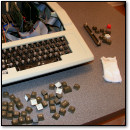Mr. Wizard Explains the Atari 1200XL (Somewhat Badly)
Tuesday, June 29th, 2010You remember Mr. Wizard’s World, right? It was a light science show for kids that aired on Nickelodeon in the 1980s. On one episode, Mr. Wizard took a peek inside the Atari 1200XL with his usual juvenile accompaniment. Here’s a clip.
The real fun begins as Mr. Wizard tries to explain the function of a row of eight chips on the motherboard around 1:40 into the segment. He quickly lapses into apparent nonsense:
You see these eight all here? This is an eight bit computer. You’ve heard of that? OK. Each one of these sends a, uh, byte off to the screen and, uh, each little dot has to have a signal from each one of those.
I probably don’t have to tell you this, but that’s not how the Atari 1200XL works. This is Internet, though, so I’ll explain it. Those eight chips are RAM chips, and their exact quantity in any computer is mostly independent of the CPU’s word size (i.e. 8-bit, 16-bit).
The fact the Atari’s CPU is 8-bit and that it contains eight RAM chips is a coincidence that apparently confused Mr. Wizard. The 1200XL had 64KB of RAM, so those are likely 8KB chips (8KB x 8 chips = 64KB). To make up the same amount of RAM, Atari could have used (for example) four 16KB chips or sixteen 4KB chips.
The rest of his explanation for those eight chips doesn’t make any sense either. But hey, it’s Mr. Wizard! Other than that, he does a pretty good job showcasing the 1200XL in a kid-show context. The joystick-sans-stick demonstration is classic Mr. Wizard fare — he’d always change things around and make you think about an issue in an unexpected way. That was his genius.
I loved Mr. Wizard’s World dearly as a kid. In fact, I learned many basic physics principles from that show. We could really use someone like him again.
P.S. If you like Mr. Wizard as much as I do, watch him on The Late Show with David Letterman in 1982.



 [ Memory Dump is an irregular series wherein Benj dives into his garage, pulls out a random technological artifact, and describes what he knows about it for your entertainment. ]
[ Memory Dump is an irregular series wherein Benj dives into his garage, pulls out a random technological artifact, and describes what he knows about it for your entertainment. ]









